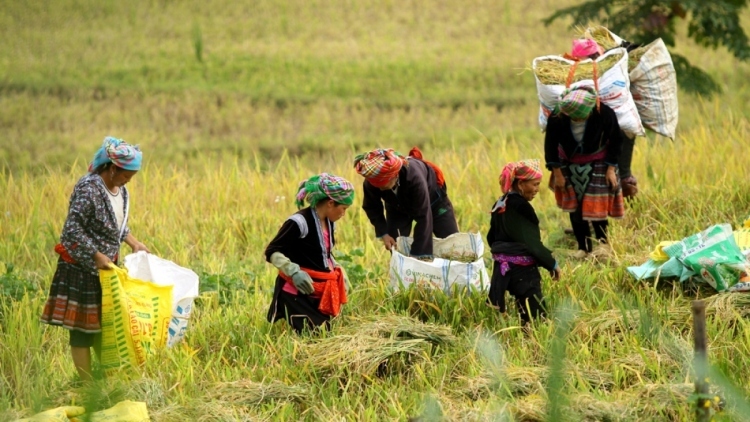Vietnam prioritises economic growth associated with caring for the poor
VOV.VN - An additional 10 million people will benefit from the Government's targeted policies and schemes relating to social protection and poverty reduction in the 2021 to 2025 period, according to the Report "Vietnam Multidimensional Poverty 2021".
Along with the goal of poverty alleviation, especially in remote areas, since 2020 the Government has adopted a National Target Program dedicated to ethnic minorities and mountainous areas.
Through two years of co-ordination among 10 agencies, ministries, and dozens of localities across the country, the programme has taken important steps aimed at realising the goal of “Leaving no one behind”.
From a household subject to persistent poverty, the family of Lo Thi Da in Quang Chieu commune of Muong Lat district was supported with trees and seeds from the local poverty reduction scheme.
After five years of implementation, her family now owns a herd of cattle and poultry of up to hundreds of heads, along with an orchard which generates tens of millions of VND each year, thereby becoming a good household in the district.
Da said, "Thanks to the support of the locality, I am less worried about capital, just raising and planting crops as I am supported with trees and seeds. Technically I also get help from books and technical guides for me to follow."
Choosing a model family as an example and replicating it is one of the ways in which Thanh Hoa province implements the plan as part of the National Target Program for ethnic minorities and those residing mountainous areas.
Ha Van Thuy, standing deputy secretary of the Quan Hoa District Party Committee, said that it remains necessary to change the way of thinking and the implementation of programmes and projects with a focus on propagandising, mobilising, and setting examples for cadres and party members. This is in addition to abandoning the idea of waiting for the State’s support.
Thuy went on to emphasize that the goal is for people to unite in carrying out the programme and select those who meet the criteria. Currently, the main focus is on investing to support regional development and socio-economic development in order to offer conditions for sustainable production development.
This comes after the National Target Program for ethnic minority areas was approved by the National Assembly in Resolution No. 120 dated June 19, 2020.
The capital allocation plan was later adopted by the National Assembly Standing Committee on May 22, 2022.
For the first time, both the Party and Government have dedicated resources and paid special attention to the programme while inheriting the development of ethnic policies from the previous period.

According to the Minister of the NA Committee for Ethnic Minority Affairs, this represents a very special programme with a large scale which primarily focuses on solving difficulties across 51 ethnic minority areas.
These represent the areas facing the most difficult socio-economic conditions in the country and are located in three strategic regions, including the Southwest, the Central Highlands, and the Northwest.
Therefore, it will take a long time to synthesize data, discuss plans with localities for a full assessment, and to put these ideas into a feasibility report after the National Assembly's Resolution is issued.
The Minister of the NA Committee for Ethnic Minority Affairs stated, “10 ministries and sectors have participated in organizing and implementing the program. This is a very large Program consisting of 10 projects, 14 sub-projects, and 36 tasks.”
The plan is very diverse in terms of featuring both new and previous policies which are still in effect, with the integration to build a system of documents guiding the implementation of the scheme being a very elaborate and thorough job.
Although the budget still faces many difficulties, the National Assembly and the Government have doubled investment resources for poverty reduction in comparison to the previous period. They have continuously directed the full implementation of the poverty reduction policy and made great efforts to carry out the poverty reduction plan, with the national target programme for sustainable poverty reduction being done in a comprehensive and multi-dimensional way and to limit poverty.
These schemes aim to create conditions for the poor and poor households in order to allow them to easily access basic social services, especially in rural, mountainous, and island areas. This will help to realise economic growth targets, ensure social security, and achieve the goal of reducing the rate of poor households.
State programmes with the active participation of the Vietnam Fatherland Front, organisations, individuals, and benefactors to help the poor in different ways have resulted in the average poverty rate of the country dropping by around 1.43% per year.
As a result, more than 650 communes and 1,200 villages nationwide have escaped from difficult circumstances, 170,000 "Great Solidarity" houses have been built, and ethnic minorities and poor households now enjoy 100% health insurance.
A social security package of nearly VND620 trillion aiming to overcome the consequences of the COVID-19 pandemic, provide thousands of tonnes of rice for emergency support, and to help people in the Central region overcome the consequences of "floods and floods, storms and storms", is therefore a great and timely relief for people. These efforts have contributed to local people enjoying the right to life, the right to medical care, and the right to a livelihood.
These efforts showcase the human rights of the Party and State of Vietnam.

